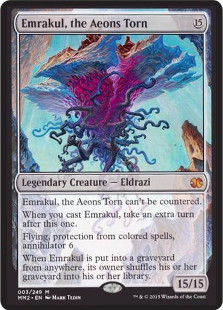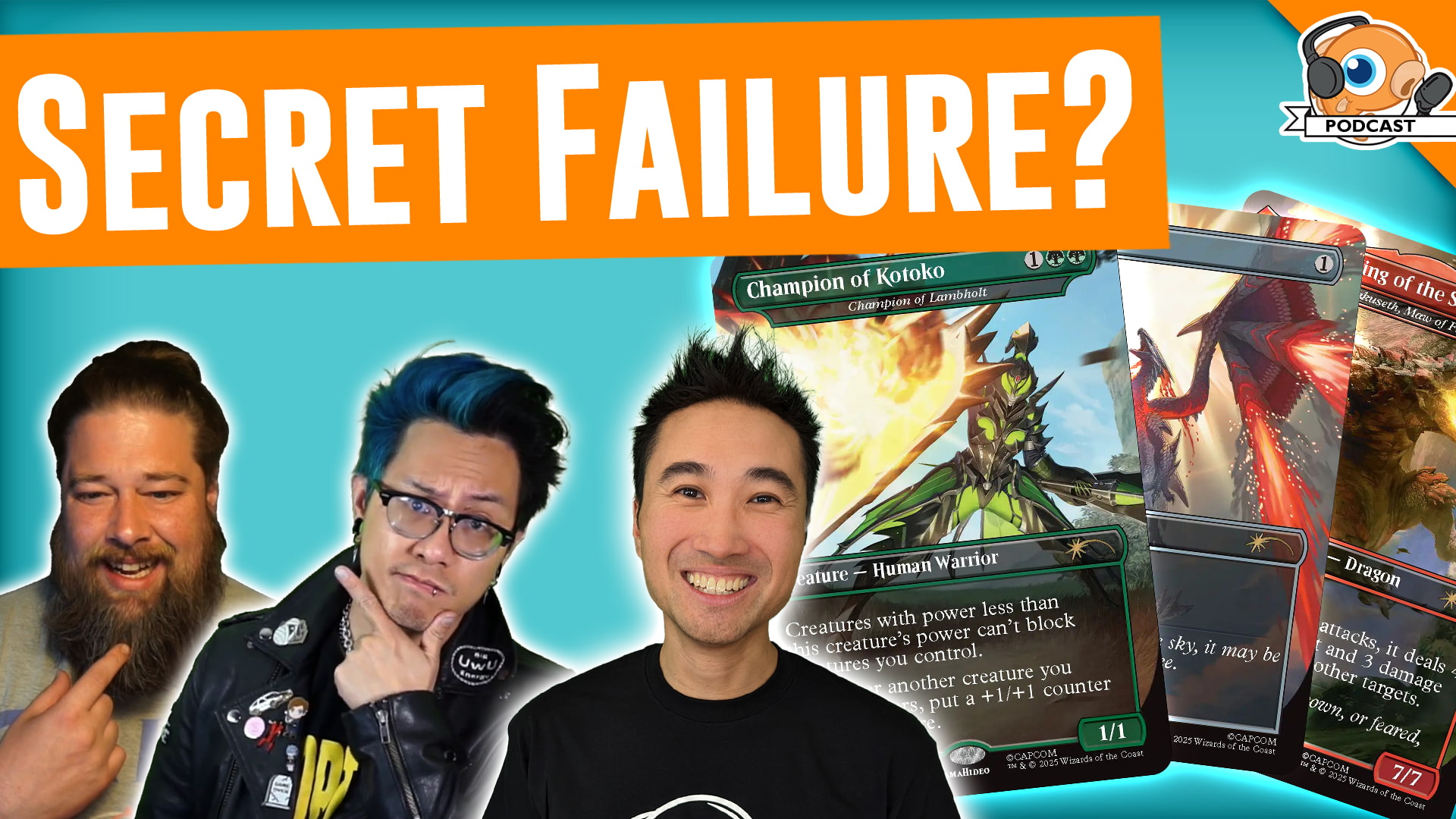Cube Goldberg Machine: Construction Decisions
Hello again! Welcome back to Cube Goldberg Machines. Today, it’s time to get into the nitty-gritty of cube construction. We’re going to touch on things like cube numbers and formats, and start talking a bit about what makes a good cube card. Making a cube is a lot of work, and I want to help guide it!


Hold up, though – does hand-choosing 360-540-720+ cards sound like pulling teeth? For me, this is half the fun - I love building cubes. I’m working on yet another one now! But if that’s not for you, there are some good options.



Many people recommend the Board Game Cube as a budget option for getting started with the format. It’s designed by Brad and Eric of the Solely Singleton cube podcast (screen names: DrRuler and OnekuoSora), aiming to be a great cube experience for beginning players – and at the same cost as a higher-end board game! It’s a great way to get started, and you get to play with some powerful cube staples like Sulfuric Vortex and Sower of Temptation. If you’re looking to get a little fancier, the same designers have put out the Miser’s Cube, another well-designed cube that will run for a few hundred dollars, and is another good option with even more kick.
![]()


Even with the Board Game Cube, though, you’re going to have to find the cards. And the sleeves. And the basic lands… If that is daunting, you can look into options like the Card Kingdom Starter Cube which comes with everything included. I’ve never dabbled with it myself, but the list looks reasonable. That being said, you ARE paying a bit extra for the convenience and supplies; this one will feel a bit more like a traditional draft environment - but with all great limited cards like Nightveil Sprite, Regal Caracal, and Reaper of the Wilds.
Either way, both are reasonable ways to get started. Even if you don't follow them directly, you can always use them for inspiration. Personally though, I would start from the ground up; I find cube to be a way to self-express. All my favorite archetypes from constructed magic are enabled in my cube, too. Either way, managing a cube can be a process of constant iteration and improvement; even if you get one of the pre-built cubes, you can (and should!) add your own spin to it later on.
Let’s say you want to try your hand at design. You are one of the proud, the strong, the brave; you’re ready to build it up yourself. Let’s get you going!
First, a reminder of the structure of cubes: Usually, each cube will have several hundred cards, equally distributed on color, with each color having an appropriate mana curve, usually clumping around 2-4, with lots of early plays and great finishers. My average nonland cost is a little under 3, for example.
A great way to get started on a cube is to just lay out all the cards you’re excited about including, and develop from there. This can either happen physically, if you have a bunch of cards lying around that you’re excited to use, or digitally, using CubeTutor.com, TappedOut, or a simple spreadsheet to keep track of what you’re looking at. Many people use CubeTutor; it's the most common way to share a cube list. My favorite method right now is Google Sheets, which I have sorted by converted mana cost, color-coded by archetype, and tracked for all changes I make. However, try out all the different platforms, and figure out what works best for you!
Once you’re there, it’s equal parts art and science. You’re going to need to play with it to know what you and your friends like, and experiment over and over until you’re happy with it. But, at the same time, there are certain decisions you should make initially to help it stay coherent and structured.
Restrictions



One of the most important first steps in building a cube is deciding what restrictions to use. For example, you can use only standard-legal cards, only cards less than a dollar, or only singletons - one of each card. These are the foundation of a cube; having these rules gives you an environment to play in. As the old, tired adage goes, “restrictions breed creativity;” having this structure gives you meaningful walls to push against. Also, importantly, it gives your drafters an easy way to understand what’s going on in your cube; should they expect Find // Finality to be a powerhouse or a pushover? Should they expect Primeval Titan as a followup for Llanowar Elves, or should we expect it to lead into something more like Vine Mare? You can take your restrictions as seriously or as loosely as you want – again, this is cube. You should do what you like! But it helps to have some lines, even if you’re going to color outside of them sometimes.
Cardpool Restrictions
One common restriction is format legality. As you might have discovered from the cubes hosted on Magic Online, their cubes are focused around Standard, Modern, Legacy, and Vintage – meaning you can only include cards legal in those formats. Just like each constructed metagame is incredibly different, these restrictions will lead to significant variations in how a cube will play out. For example, Modern cubes often revolve around value and planeswalkers (because the broken enablers like Krark-Clan Ironworks or Prized Amalgam don’t work as well when you can’t run all four). On the other hand, Vintage cubes often get to run the full Power 9 (Black Lotus, Ancestral Recall, etc.), and combo decks like storm, reanimator, and sneak attack are fully enabled and quite strong. Legacy cubes usually sit somewhere in between; Standard cubes are such a moving target (because of rotation) that it’s hard to say anything definitive about them, except that the lack of degenerate enablers often leads to more of a traditional limited feel. (In all of them, mono-colored aggro decks like Burn and White Weenies are often very powerful. Turns out Goblin Guide is good in formats where people can’t normally win before turn 5.)




So how do you choose between all those options? One way of thinking about it: how broken do you want your drafters’ decks to be? If you want to see Yawgmoth's Will into Tendrils of Agony for 40 or turn 3 hasty Emrakul, the Aeons Torns, then you want an older environment. This can be a lot of fun, but these kinds of formats can occasionally lead to non-games as well, where one person just steamrolls the other. It’s hard for Thalia, Guardian of Thraben to keep up with a turn 1 or 2 Griselbrand. We’ll come back to this though.




If this is all starting to sound very expensive, there are some other great formats to consider: Pauper and Peasant! If you’re unfamiliar with the formats, Pauper allows only commons, while Peasant also includes uncommons. This is a great way to build a budget environment – but be forewarned! Although you aren’t running rares, the formats can still be incredibly powerful. Ever heard of Brainstorm? How about Delver of Secrets or Lightning Bolt or Rancor? (If you do go down this road, you’ll also have to be careful to power down blue – it can be very threatening if you run older cards!)




There’s another nice budget option: cards that cost less than a dollar/two dollars/57₵/whatever seems reasonable – or that sum up under some maximum total. There's an amazing number of high-power, fun cards that are very cheap. Consider Unexpectedly Absent, Bounty of the Luxa, or Figure of Destiny. The recently (ish) banned Smuggler's Copter is another great tool for lots of archetypes, and it will only set you back two greenbacks. Or, you can only use cards you already own! When I first started designing a cube I resolved to never buy cards for it – only using cards from my existing collection, derelict standard and modern decks, and drafts. My priorities were in other places. Soon, cube captured my heart, and those rules went out the window. Be careful! The same might happen to you.
Other Restrictions
Beyond the cardpool, there are a few other important considerations when you’re starting out. For example, cubes are often singleton – running only one of each card. This helps in several ways. First, from a play perspective, it promotes diverse games. Just like Commander games are high-variance because you can’t count on drawing specific cards each game, cubes with only one copy of each card will be different every time – allowing people to draft them over and over without much change. This is the biggest reason singleton cubes are the industry standard.
Beyond that, singleton cubes can be easier to balance. When you have to only pick between “in or out,” it reduces the complexity of your decisions – much easier than “one, two, three, or none!”
That being said, singleton has its own drawbacks. If there is a single, key card to enable an archetype, fixating on singleton can cripple or even completely invalidate certain strategies. Birthing Pod can be a good example of this. Because it is hard to ensure you will find it in a draft – and then your deck – it’s hard to build around. (Fortunately, Birthing Pod is alright without being the centerpiece of a deck, so you will still find it in some cubes.)


Singleton also prevents running some sweet cards, most notably Squadron Hawk, Accumulated Knowledge, and Cloudpost. However, these rules tend to be very effective, so I would recommend following them at first when starting a cube.
Cube designers also always face a question – how seriously do they want to treat the format? Conspiracies, from – uh – Conspiracy, are a sweet way to trick out your cube. Some of them are extremely strong in powerful environments. Ever wanted to Double Stroke a Temporal Mastery? They scale well with more powerful environments, where innocuous cards like Muzzio's Preparations can combine with Kitchen Finks for infinite life with a sac outlet. Unexpected Potential allows you to splash Maelstrom Nexus in your Green-Black value deck.




This starts to be a bit of a slippery slope, though. Do you allow yourself to use Un-cards? Blast from the Past and Who // What // When // Where // Why are reasonable magic cards, if a bit wacky. But Staying Power is just plain bizarre, and Magical Hacker is an unreasonable combo with planeswalkers. There are a ton of sweet un-cards, but they can be very hard to include without creating some strange dynamics. Personally, I’ve taken the plunge; all of the above cards have been in and out of my cube at certain points. I think Un is Fun. Not all of my drafters have agreed; that's part of why some of the cards have come out in the first place. But you’ll have to make that assessment for yourself!


Finally, the last parameter to think about is size. A bigger cube means that you get to fit more sweet stuff in – but a smaller cube means you’re more likely to see your favorites each draft! If you have two-card combos, then you really want to make sure that you draft the full cube each time; on the other hand, if you see everything all the time, things run the risk of getting stale. If you always take over the game with Split Screen or Splinter Twin, your friends might start to get frustrated! (Split Screen is nuts. Lots of fun, and very powerful.)
Personally, I like to keep my cube at about 540 cards. This allows drafters to see about two thirds of the cube each time, which feels like it finds the balance between enabling archetypes and staying fresh. For me, I don’t keep to this number strictly, but that’s actually quite unusual among designers; most will hold fast to a multiple of 180 without any variation. This makes a lot of sense, going back to “restrictions breed creativity,” but it also makes adding things and taking them out much more of a challenge sometimes. I like not having to always swap one for one! A word of warning if you take this approach: for balance, it’s important to keep the number of cards in each color very close to equal, so be mindful of the distribution.
Wrapping Up
Hope this one was helpful! I know it’s maybe been a bit dry; getting started with cubing can require a little bit of detail-oriented stuff at the beginning. Next time, we’ll get into the other important decisions to start with – different archetypes and themes that can shape your cube! And, soon after that, actual breakdowns of example cubes. These are much more fun, I promise, but I wanted to make sure I did this stuff well so you got started on the right foot.
One last detail: there are a few resources that are great places to scour for more information, or tap into the active cube community. On Reddit, r/MtgCube is an all-purpose forum, while Magic Salvation has another good forum for more niche discussions. Each has its own tone; explore, and find your own home!
(As a side note: one of the reasons I haven't provided a list for my cube partially because it's fairly unorthodox. I don't really recommend running Maelstrom Nexus or many of these other cards in most cubes; I don't want to lead you astray! My drafters are mostly ok when I push these boundaries, but not everyone will be. Feel it out first!)













